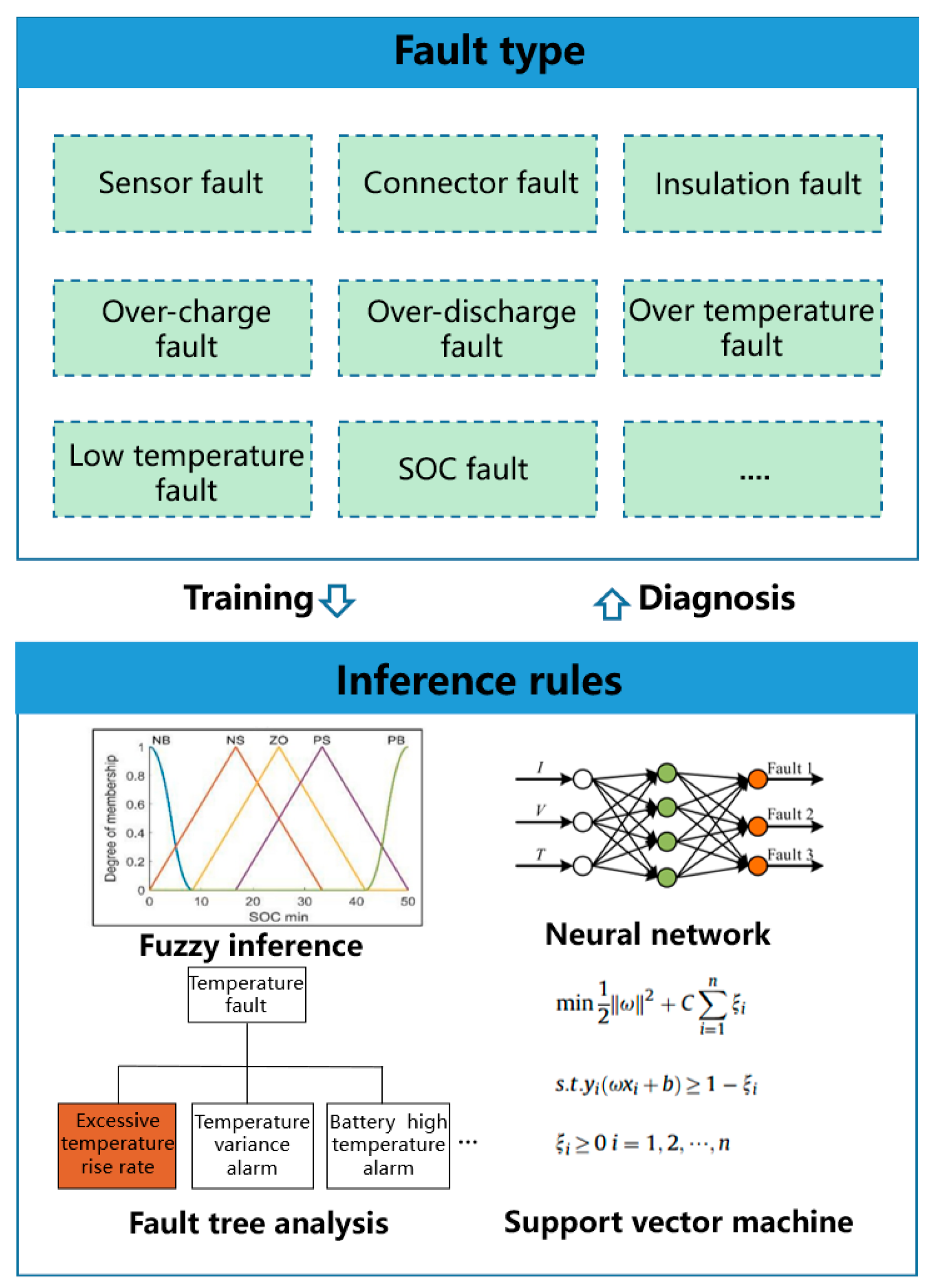Towards High-Safety Lithium-Ion Battery Diagnosis Methods
Abstract
1. Introduction
2. Lithium-Ion Battery Fault Sources
2.1. Lithium-Ion Battery Aging Mechanism
2.2. Common Abnormalities of Lithium-Ion Batteries
3. Lithium-Ion Battery Fault Diagnosis Method
3.1. Statistical Analysis-Based Method
3.2. Analytic Model-Based Method
3.2.1. State Estimation Method
3.2.2. Parameter Estimation Method
3.2.3. Parity Space Method
3.3. Signal Processing-Based Method
3.4. Knowledge-Based Method
3.4.1. Fault Tree Analysis
3.4.2. Fuzzy Logic
3.5. Data-Driven Method
3.5.1. Neural Network
3.5.2. Support Vector Machine
4. Conclusions and Perspectives
Author Contributions
Funding
Data Availability Statement
Conflicts of Interest
References
- Fu, S.; Lyu, T.; Min, F.; Luo, W.; Luo, C.; Wu, L.; Xie, J. Review of estimation methods on SOC of lithium-ion batteries in electric vehicles. Energy Storage Sci. Technol. 2021, 10, 1127–1136. [Google Scholar]
- Li, C.; Xiao, F.; Fan, Y.; Tang, X.; Yang, G. Joint Estimation of the State of Charge and the State of Health Based on Deep Learning for Lithium-ion Batteries. Proc. Chin. Soc. Electr. Eng. 2021, 41, 681–691. [Google Scholar]
- Qiu, Y.; Jiang, F. A review on passive and active strategies of enhancing the safety of lithium-ion batteries. Int. J. Heat Mass Transf. 2022, 184, 122288. [Google Scholar] [CrossRef]
- Wei, P.; Li, H.-X. Multiscale dynamic construction for abnormality detection and localization of Li-ion batteries. Appl. Energy 2022, 325, 119814. [Google Scholar] [CrossRef]
- Xiong, R.; Sun, W.; Yu, Q.; Sun, F. Research progress, challenges and prospects of fault diagnosis on battery system of electric vehicles. Appl. Energy 2020, 279, 115855. [Google Scholar] [CrossRef]
- Chen, Z.; Zheng, C.; Lin, T.; Yang, Q. Multifault Diagnosis of Li-Ion Battery Pack Based on Hybrid System. IEEE Trans. Transp. Electrif. 2022, 8, 1769–1784. [Google Scholar] [CrossRef]
- Jiang, J.; Li, T.; Chang, C.; Yang, C.; Liao, L. Fault diagnosis method for lithium-ion batteries in electric vehicles based on isolated forest algorithm. J. Energy Storage 2022, 50, 104177. [Google Scholar] [CrossRef]
- Wu, C.; Zhu, C.; Ge, Y.; Zhao, Y. A Review on Fault Mechanism and Diagnosis Approach for Li-Ion Batteries. J. Nanomater. 2015, 2015, 631263. [Google Scholar] [CrossRef]
- Schmid, M.; Kneidinger, H.-G.; Endisch, C. Data-Driven Fault Diagnosis in Battery Systems Through Cross-Cell Monitoring. IEEE Sens. J. 2021, 21, 1829–1837. [Google Scholar] [CrossRef]
- Hu, X.; Zhang, K.; Liu, K.; Lin, X.; Dey, S.; Onori, S. Advanced Fault Diagnosis for Lithium-Ion Battery Systems: A Review of Fault Mechanisms, Fault Features, and Diagnosis Procedures. IEEE Ind. Electron. Mag. 2020, 14, 65–91. [Google Scholar] [CrossRef]
- Wang, Y.; Meng, D.; Li, R.; Zhou, Y.; Zhang, X. Research on interactive multi-model fault diagnosis method of Li-ion battery based on noise suppression. Int. J. Energy Res. 2021, 45, 13198–13218. [Google Scholar] [CrossRef]
- Su, T.; Lyu, N.; Zhao, Z.; Wang, H.; Jin, Y. Safety warning of lithium-ion battery energy storage station via venting acoustic signal detection for grid application. J. Energy Storage 2021, 38, 102498. [Google Scholar] [CrossRef]
- Li, D.; Zhang, Z.; Liu, P.; Wang, Z.; Zhang, L. Battery Fault Diagnosis for Electric Vehicles Based on Voltage Abnormality by Combining the Long Short-Term Memory Neural Network and the Equivalent Circuit Model. IEEE Trans. Power Electron. 2021, 36, 1303–1315. [Google Scholar] [CrossRef]
- Qiao, D.; Wei, X.; Fan, W.; Jiang, B.; Lai, X.; Zheng, Y.; Tang, X.; Dai, H. Toward safe carbon–neutral transportation: Battery internal short circuit diagnosis based on cloud data for electric vehicles. Appl. Energy 2022, 317, 119168. [Google Scholar] [CrossRef]
- Xue, Q.; Li, G.; Zhang, Y.; Shen, S.; Chen, Z.; Liu, Y. Fault diagnosis and abnormality detection of lithium-ion battery packs based on statistical distribution. J. Power Sources 2021, 482, 228964. [Google Scholar] [CrossRef]
- Martinet, S.; Durand, R.; Ozil, P.; Leblanc, P.; Blanchard, P. Application of electrochemical noise analysis to the study of batteries: State-of-charge determination and overcharge detection. J. Power Sources 1999, 83, 93–99. [Google Scholar] [CrossRef]
- Broussely, M.; Herreyre, S.; Biensan, P.; Kasztejna, P.; Nechev, K.; Staniewicz, R.J. Aging mechanism in Li ion cells and calendar life predictions. J. Power Sources 2001, 97–98, 13–21. [Google Scholar] [CrossRef]
- Agubra, V.; Fergus, J. Lithium Ion Battery Anode Aging Mechanisms. Materials 2013, 6, 1310–1325. [Google Scholar] [CrossRef]
- Vetter, J.; Novak, P.; Wagner, M.R.; Veit, C.; Moller, K.C.; Besenhard, J.O.; Winter, M.; Wohlfahrt-Mehrens, M.; Vogler, C.; Hammouche, A. Ageing mechanisms in lithium-ion batteries. J. Power Sources 2005, 147, 269–281. [Google Scholar] [CrossRef]
- Han, X.; Lu, L.; Zheng, Y.; Feng, X.; Li, Z.; Li, J.; Ouyang, M. A review on the key issues of the lithium ion battery degradation among the whole life cycle. eTransportation 2019, 1, 100005. [Google Scholar] [CrossRef]
- Liu, J.; Duan, Q.; Ma, M.; Zhao, C.; Sun, J.; Wang, Q. Aging mechanisms and thermal stability of aged commercial 18650 lithium ion battery induced by slight overcharging cycling. J. Power Sources 2020, 445, 227263. [Google Scholar] [CrossRef]
- Lyu, C.; Zhao, Y.; Luo, W.; Wang, L. Aging mechanism analysis and its impact on capacity loss of lithium ion batteries. In Proceedings of 14th IEEE Conference on Industrial Electronics and Applications (ICIEA), Xi’an, China, 19–21 June 2019; IEEE: Piscataway, NJ, USA; pp. 2148–2153. [Google Scholar]
- Xiong, R.; Pan, Y.; Shen, W.; Li, H.; Sun, F. Lithium-ion battery aging mechanisms and diagnosis method for automotive applications: Recent advances and perspectives. Renew. Sustain. Energy Rev. 2020, 131, 110048. [Google Scholar] [CrossRef]
- Song, Y.; Su, L.; Wang, C.; Zhang, Y.; Zhang, J. Research progress of aging for lithium ion batteries. Chin. J. Power Sources 2018, 42, 1578–1581. [Google Scholar]
- Ren, D.; Feng, X.; Han, X.; Lu, L.; Ouyang, M. Recent progress on evolution of safety performance of lithium-ion battery during aging process. Energy Storage Sci. Technol. 2018, 7, 957–966. [Google Scholar]
- Guo, J.; Li, Y.Q.; Pedersen, K.; Stroe, D.I. Lithium-Ion Battery Operation, Degradation, and Aging Mechanism in Electric Vehicles: An Overview. Energies 2021, 14, 5220. [Google Scholar] [CrossRef]
- Birkl, C.R.; Roberts, M.R.; McTurk, E.; Bruce, P.G.; Howey, D.A. Degradation diagnostics for lithium ion cells. J. Power Sources 2017, 341, 373–386. [Google Scholar] [CrossRef]
- Frank, P.M. Fault-Diagnosis in Dynamic-Systems Using Analytical and Knowledge-Based Redundancy—A Survey and Some New Results. Automatica 1990, 26, 459–474. [Google Scholar] [CrossRef]
- Hong, J.; Wang, Z.; Chen, W.; Wang, L. Multi-fault synergistic diagnosis of battery systems based on the modified multi-scale entropy. Int. J. Energy Res. 2019, 43, 8350–8369. [Google Scholar] [CrossRef]
- Shang, Y.; Lu, G.; Kang, Y.; Zhou, Z.; Duan, B.; Zhang, C. A multi-fault diagnosis method based on modified Sample Entropy for lithium-ion battery strings. J. Power Sources 2020, 446, 227275. [Google Scholar] [CrossRef]
- Qiu, Y.; Cao, W.; Peng, P.; Jiang, F. A novel entropy-based fault diagnosis and inconsistency evaluation approach for lithium-ion battery energy storage systems. J. Energy Storage 2021, 41, 102852. [Google Scholar] [CrossRef]
- Wang, P.; Gong, Q.; Zhang, J.A.; Cheng, Z. An Online State of Health Prediction Method for Lithium Batteries Based on Combination of Data-Driven and Empirical Model. Trans. China Electrotech. Soc. 2021, 36, 5201–5212. [Google Scholar]
- Tagade, P.; Hariharan, K.S.; Ramachandran, S.; Khandelwal, A.; Naha, A.; Kolake, S.M.; Han, S.H. Deep Gaussian process regression for lithium-ion battery health prognosis and degradation mode diagnosis. J. Power Sources 2020, 445, 227281. [Google Scholar] [CrossRef]
- Yang, J.; Jung, J.; Ghorbanpour, S.; Han, S. Data–Driven Fault Diagnosis and Cause Analysis of Battery Pack with Real Data. Energies 2022, 15, 1647. [Google Scholar] [CrossRef]
- Kang, Y.; Yang, X.; Zhou, Z.; Duan, B.; Liu, Q.; Shang, Y.; Zhang, C. A comparative study of fault diagnostic methods for lithium-ion batteries based on a standardized fault feature comparison method. J. Clean. Prod. 2021, 278, 123424. [Google Scholar] [CrossRef]
- Xu, X.; Tang, S.; Yu, C.; Xie, J.; Han, X.; Ouyang, M. Remaining Useful Life Prediction of Lithium-ion Batteries Based on Wiener Process Under Time-Varying Temperature Condition. Reliab. Eng. Syst. Saf. 2021, 214, 107675. [Google Scholar] [CrossRef]
- Xia, B.; Shang, Y.; Nguyen, T.; Mi, C. A correlation based fault detection method for short circuits in battery packs. J. Power Sources 2017, 337, 1–10. [Google Scholar] [CrossRef]
- Wang, Z.; Hong, J.; Liu, P.; Zhang, L. Voltage fault diagnosis and prognosis of battery systems based on entropy and Z-score for electric vehicles. Appl. Energy 2017, 196, 289–302. [Google Scholar] [CrossRef]
- Li, J.; Xiao, H. Review on modeling of lithium-ion battery. Energy Storage Sci. Technol. 2022, 11, 697–703. [Google Scholar]
- Gao, Y.; Liu, K.; Zhu, C.; Zhang, X.; Zhang, D. Co-Estimation of State-of-Charge and State-of- Health for Lithium-Ion Batteries Using an Enhanced Electrochemical Model. IEEE Trans. Ind. Electron. 2022, 69, 2684–2696. [Google Scholar] [CrossRef]
- Xiong, R.; Yang, R.; Chen, Z.; Shen, W.; Sun, F. Online Fault Diagnosis of External Short Circuit for Lithium-Ion Battery Pack. IEEE Trans. Ind. Electron. 2020, 67, 1081–1091. [Google Scholar] [CrossRef]
- Chen, L.; Wang, H.; Li, Y.; Zhang, M.; Huang, J.; Pan, H. Battery State-Of-Health Estimation by Using Metabolic Extreme Learning Machine. Automot. Eng. 2021, 43, 10–18. [Google Scholar]
- Wang, Y.; Zhou, C.; Zhao, G.; Chen, Z. A framework for battery internal temperature and state-of-charge estimation based on fractional-order thermoelectric model. Trans. Inst. Meas. Control 2022. [Google Scholar] [CrossRef]
- Kong, S.; Saif, M.; Cui, G. Estimation and Fault Diagnosis of Lithium-Ion Batteries: A Fractional-Order System Approach. Math. Probl. Eng. 2018, 2018, 8705363. [Google Scholar] [CrossRef]
- Li, X.; Zhang, Z.; Wang, W.; Tian, Y.; Li, D.; Tian, J. Multiphysical field measurement and fusion for battery electric-thermal-contour performance analysis. Appl. Energy 2020, 262, 114518. [Google Scholar] [CrossRef]
- Tang, Y.; Wu, L.; Wei, W.; Wen, D.; Guo, Q.; Liang, W.; Xiao, L. Study of the thermal properties during the cyclic process of lithium ion power batteries using the electrochemical-thermal coupling model. Appl. Therm. Eng. 2018, 137, 11–22. [Google Scholar] [CrossRef]
- Zhengxin, J.; Qin, S.; Yujiang, W.; Hanlin, W.; Bingzhao, G.; Lin, H. An Immune Genetic Extended Kalman Particle Filter approach on state of charge estimation for lithium-ion battery. Energy 2021, 230, 120805. [Google Scholar] [CrossRef]
- Lin, T.; Chen, Z.; Zheng, C.; Huang, D.; Zhou, S. Fault Diagnosis of Lithium-Ion Battery Pack Based on Hybrid System and Dual Extended Kalman Filter Algorithm. IEEE Trans. Transp. Electrif. 2021, 7, 26–36. [Google Scholar] [CrossRef]
- Wang, S.L.; Fernandez, C.; Xie, Z.W.; Li, X.X.; Zou, C.Y.; Li, Q. A novel weight coefficient calculation method for the real-time state monitoring of the lithium-ion battery packs under the complex current variation working conditions. Energy Sci. Eng. 2019, 7, 3038–3057. [Google Scholar] [CrossRef]
- Hou, J.; Yang, Y.; Gao, T. A normal-gamma-based adaptive dual unscented Kalman filter for battery parameters and state-of-charge estimation with heavy-tailed measurement noise. Int. J. Energy Res. 2020, 44, 3510–3525. [Google Scholar] [CrossRef]
- Wei, J.; Dong, G.; Chen, Z. Lyapunov-Based Thermal Fault Diagnosis of Cylindrical Lithium-Ion Batteries. IEEE Trans. Ind. Electron. 2020, 67, 4670–4679. [Google Scholar] [CrossRef]
- Liu, P.; Li, Y.; Liang, X. Estimation of Lithium Battery SOC Based on FFRLS and AUKF. Automob. Technol. 2022, 21–27. [Google Scholar] [CrossRef]
- Chen, H.; Tian, E.; Wang, L. State-Of-Charge Estimation of Lithium-Ion Batteries Subject to Random Sensor Data Unavailability: A Recursive Filtering Approach. IEEE Trans. Ind. Electron. 2022, 69, 5175–5184. [Google Scholar] [CrossRef]
- Lyu, D.; Niu, G.; Liu, E.; Yang, T.; Chen, G.; Zhang, B. Uncertainty Management and Differential Model Decomposition for Fault Diagnosis and Prognosis. IEEE Trans. Ind. Electron. 2022, 69, 5235–5246. [Google Scholar] [CrossRef]
- Ge, Y.; Zhang, F.; Ren, Y. Lithium Ion Battery Health Prediction via Variable Mode Decomposition and Deep Learning Network with Self-Attention Mechanism. Front. Energy Res. 2022, 10, 810490. [Google Scholar] [CrossRef]
- Ma, Q. The state of charge estimation of lithium-ions battery using combined multi-population genetic algorithm—BP and Kalman filter methods. Int. J. Electrochem. Sci. 2022, 17, 220214. [Google Scholar] [CrossRef]
- Chen, J.; Lu, C.; Chen, C.; Cheng, H.; Xuan, D. An Improved Gated Recurrent Unit Neural Network for State-Of-Charge Estimation of Lithium-Ion Battery. Appl. Sci. 2022, 12, 2305. [Google Scholar] [CrossRef]
- Yan, W.; Zhang, B.; Dou, W.; Liu, D.; Peng, Y. Low-Cost Adaptive Lebesgue Sampling Particle Filtering Approach for Real-Time Li-Ion Battery Diagnosis and Prognosis. IEEE Trans. Autom. Sci. Eng. 2017, 14, 1601–1611. [Google Scholar] [CrossRef]
- Feng, X.; Pan, Y.; He, X.; Wang, L.; Ouyang, M. Detecting the internal short circuit in large-format lithium-ion battery using model-based fault-diagnosis algorithm. J. Energy Storage 2018, 18, 26–39. [Google Scholar] [CrossRef]
- Pan, Y.; Feng, X.; Zhang, M.; Han, X.; Lu, L.; Ouyang, M. Internal short circuit detection for lithium-ion battery pack with parallel-series hybrid connections. J. Clean. Prod. 2020, 255, 120277. [Google Scholar] [CrossRef]
- Chow, E.Y.; Willsky, A.S. Analytical Redundancy and the Design of Robust Failure-Detection Systems. IEEE Trans. Autom. Control 1984, 29, 603–614. [Google Scholar] [CrossRef]
- Odendaal, H.M.; Jones, T. Actuator fault detection and isolation: An optimised parity space approach. Control Eng. Pract. 2014, 26, 222–232. [Google Scholar] [CrossRef]
- Pan, F.; Ma, B.; Gao, Y.; Xu, M.; Gong, D. Parity Space Approach for Fault Diagnosis of Lithium-Ion Battery Sensor for Electric Vehicles. Automot. Eng. 2019, 41, 831–838. [Google Scholar]
- Staroswiecki, M.; Comtet-Varga, G. Analytical redundancy relations for fault detection and isolation in algebraic dynamic systems. Automatica 2001, 37, 687–699. [Google Scholar] [CrossRef]
- Jiang, J.; Cong, X.; Li, S.; Zhang, C.; Zhang, W.; Jiang, Y. A Hybrid Signal-Based Fault Diagnosis Method for Lithium-Ion Batteries in Electric Vehicles. IEEE Access 2021, 9, 19175–19186. [Google Scholar] [CrossRef]
- Yao, L.; Xiao, Y.; Gong, X.; Hou, J.; Chen, X. A novel intelligent method for fault diagnosis of electric vehicle battery system based on wavelet neural network. J. Power Sources 2020, 453, 227870. [Google Scholar] [CrossRef]
- Ding, P.; Liu, X.; Li, H.; Huang, Z.; Zhang, K.; Shao, L.; Abedinia, O. Useful life prediction based on wavelet packet decomposition and two-dimensional convolutional neural network for lithium-ion batteries. Renew. Sustain. Energy Rev. 2021, 148, 111287. [Google Scholar] [CrossRef]
- Zhang, Y.; Tang, Q.; Zhang, Y.; Wang, J.; Stimming, U.; Lee, A.A. Identifying degradation patterns of lithium ion batteries from impedance spectroscopy using machine learning. Nat. Commun. 2020, 11, 1706. [Google Scholar] [CrossRef] [PubMed]
- Locorotondo, E.; Cultrera, V.; Pugi, L.; Berzi, L.; Pierini, M.; Lutzemberger, G. Development of a battery real-time state of health diagnosis based on fast impedance measurements. J. Energy Storage 2021, 38, 102566. [Google Scholar] [CrossRef]
- Wang, L.-Y.; Wang, L.-F.; Liu, W.; Zhang, Y.-W. Research on Fault Diagnosis System of Electric Vehicle Power Battery Based on OBD Technology. In Proceedings of International Conference on Circuits, Devices and Systems (ICCDS), Chengdu, China, 5–8 September 2017; IEEE: Piscataway, NJ, USA; pp. 95–99. [Google Scholar]
- Fan, Y.; Deyun, X. Probabilistic SDG Model and Approach to Inference for Fault Analysis. Control Decis. 2006, 21, 487–491,496. [Google Scholar]
- Muddappa, V.K.S.; Anwar, S. Electrochemical Model Based Fault Diagnosis of Li-Ion Battery Using Fuzzy Logic. In Proceedings of ASME International Mechanical Engineering Congress and Exposition (IMECE), Montreal, QC, Canada, 14–20 November 2015; American Society of Mechanical Engineers: New York, NY, USA. [Google Scholar]
- Held, M.; Brönnimann, R. Safe cell, safe battery? Battery fire investigation using FMEA, FTA and practical experiments. Microelectron. Reliab. 2016, 64, 705–710. [Google Scholar] [CrossRef]
- Gao, H.; Meng, X.; Qian, K.; Zhang, W. Research on Intelligent Diagnosis Strategy and Treatment Method of ev Charging Fault. In Proceedings of 5th International Conference on Control, Automation and Robotics (ICCAR), Beijing, China, 19–22 April 2019; IEEE: Piscataway, NJ, USA; pp. 47–50. [Google Scholar]
- Sun, Z.; Wang, Z.; Liu, P.; Zhang, Z.; Chen, Y.; Qu, C. Overview of Fault Diagnosis in New Energy Vehicle Power Battery System. J. Mech. Eng. 2021, 57, 87–104. [Google Scholar]
- Wu, C.; Zhu, C.; Ge, Y. A New Fault Diagnosis and Prognosis Technology for High-Power Lithium-Ion Battery. IEEE Trans. Plasma Sci. 2017, 45, 1533–1538. [Google Scholar] [CrossRef]
- Li, K.; Zhou, P.; Lu, Y.; Han, X.; Li, X.; Zheng, Y. Battery life estimation based on cloud data for electric vehicles. J. Power Sources 2020, 468, 228192. [Google Scholar] [CrossRef]
- Li, R.; Li, S.; Zhou, Y. Fault Diagnosis of Lithium Battery based on Fuzzy Bayesian Network. Int. J. Perform. Eng. 2018, 14, 2302. [Google Scholar] [CrossRef]
- Yao, L.; Fang, Z.; Xiao, Y.; Hou, J.; Fu, Z. An Intelligent Fault Diagnosis Method for Lithium Battery Systems Based on Grid Search Support Vector Machine. Energy 2021, 214, 118866. [Google Scholar] [CrossRef]
- Zhao, Y.; Liu, P.; Wang, Z.; Zhang, L.; Hong, J. Fault and defect diagnosis of battery for electric vehicles based on big data analysis methods. Appl. Energy 2017, 207, 354–362. [Google Scholar] [CrossRef]
- Zhang, W.; Li, X.; Li, X. Deep learning-based prognostic approach for lithium-ion batteries with adaptive time-series prediction and on-line validation. Measurement 2020, 164, 108052. [Google Scholar] [CrossRef]
- Ma, Y.; Wu, L.; Guan, Y.; Peng, Z. The capacity estimation and cycle life prediction of lithium-ion batteries using a new broad extreme learning machine approach. J. Power Sources 2020, 476, 228581. [Google Scholar] [CrossRef]
- Zhang, C.-Y.; Wang, S.-L.; Yu, C.-M.; Xie, Y.-X.; Fernandez, C. Improved Particle Swarm Optimization-Extreme Learning Machine Modeling Strategies for the Accurate Lithium-ion Battery State of Health Estimation and High-adaptability Remaining Useful Life Prediction. J. Electrochem. Soc. 2022, 169, 080520. [Google Scholar] [CrossRef]
- Lee, J.-H.; Lee, I.-S. Estimation of Online State of Charge and State of Health Based on Neural Network Model Banks Using Lithium Batteries. Sensors 2022, 22, 5536. [Google Scholar] [CrossRef]
- Feng, X.; Weng, C.; He, X.; Han, X.; Lu, L.; Ren, D.; Ouyang, M. Online State-of-Health Estimation for Li-Ion Battery Using Partial Charging Segment Based on Support Vector Machine. IEEE Trans. Veh. Technol. 2019, 68, 8583–8592. [Google Scholar] [CrossRef]
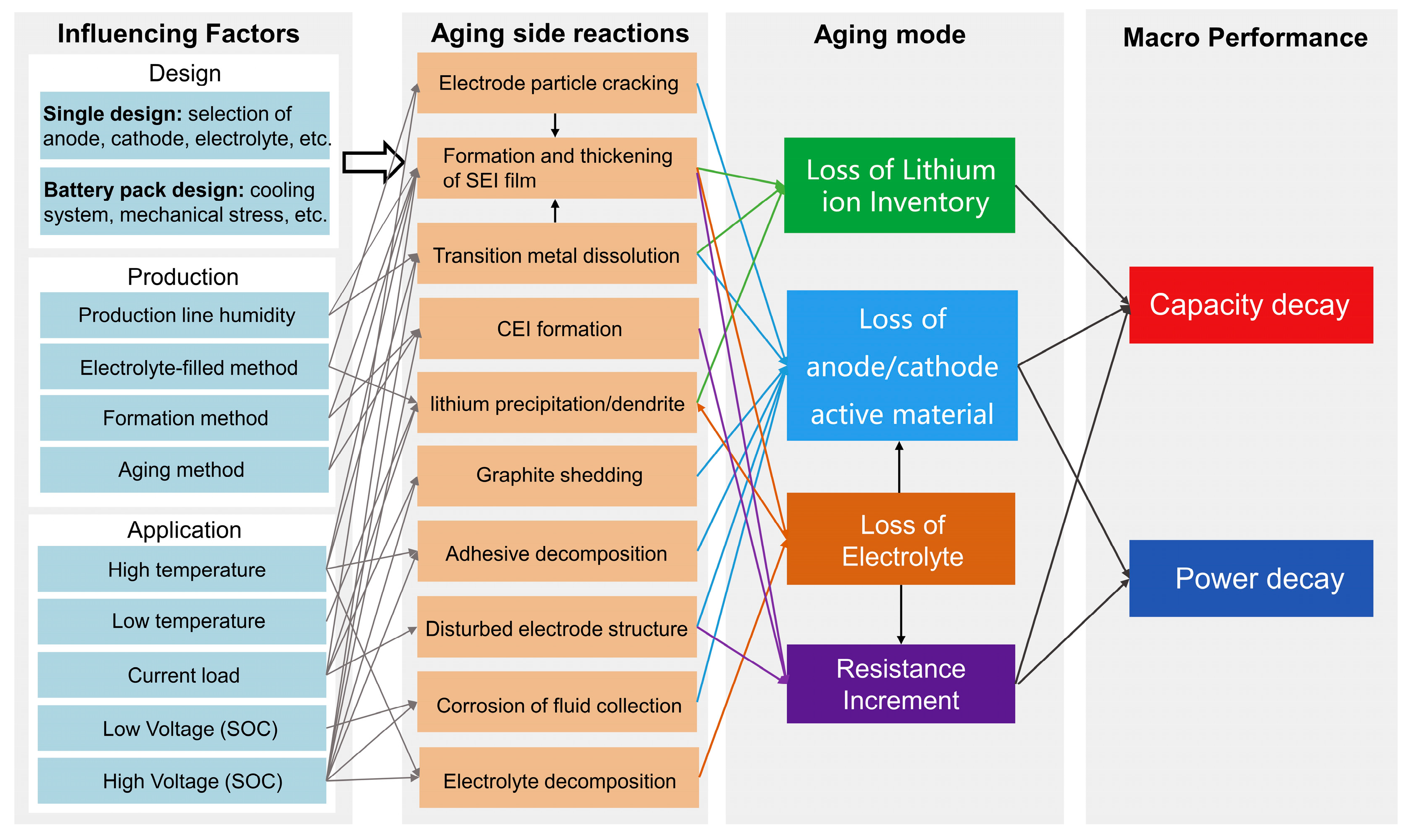
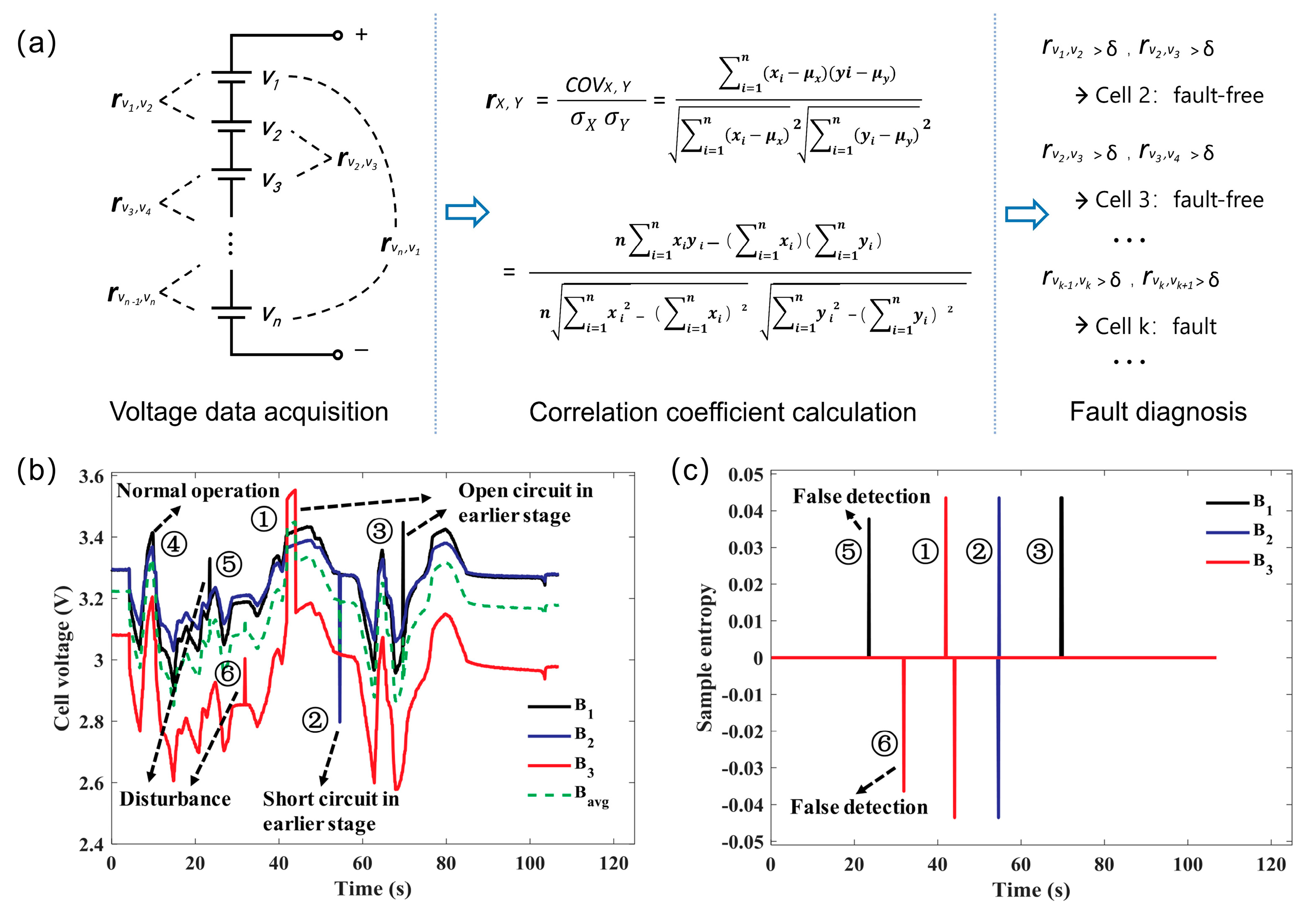
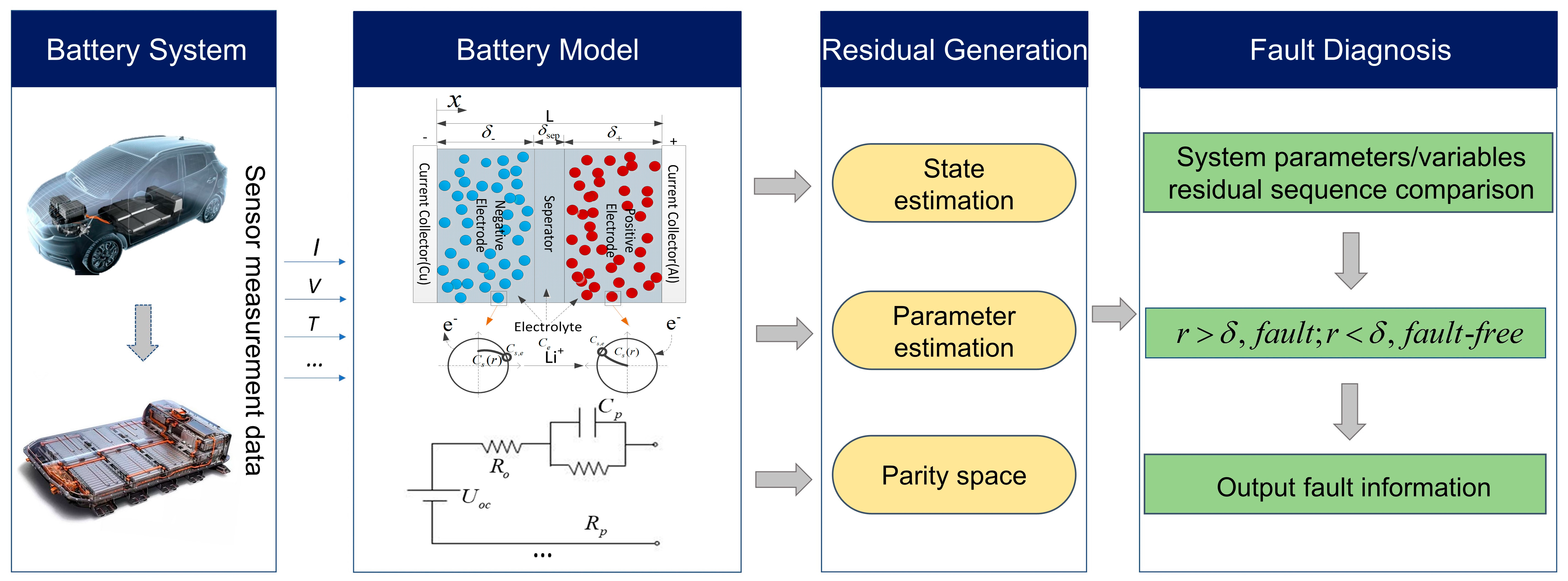
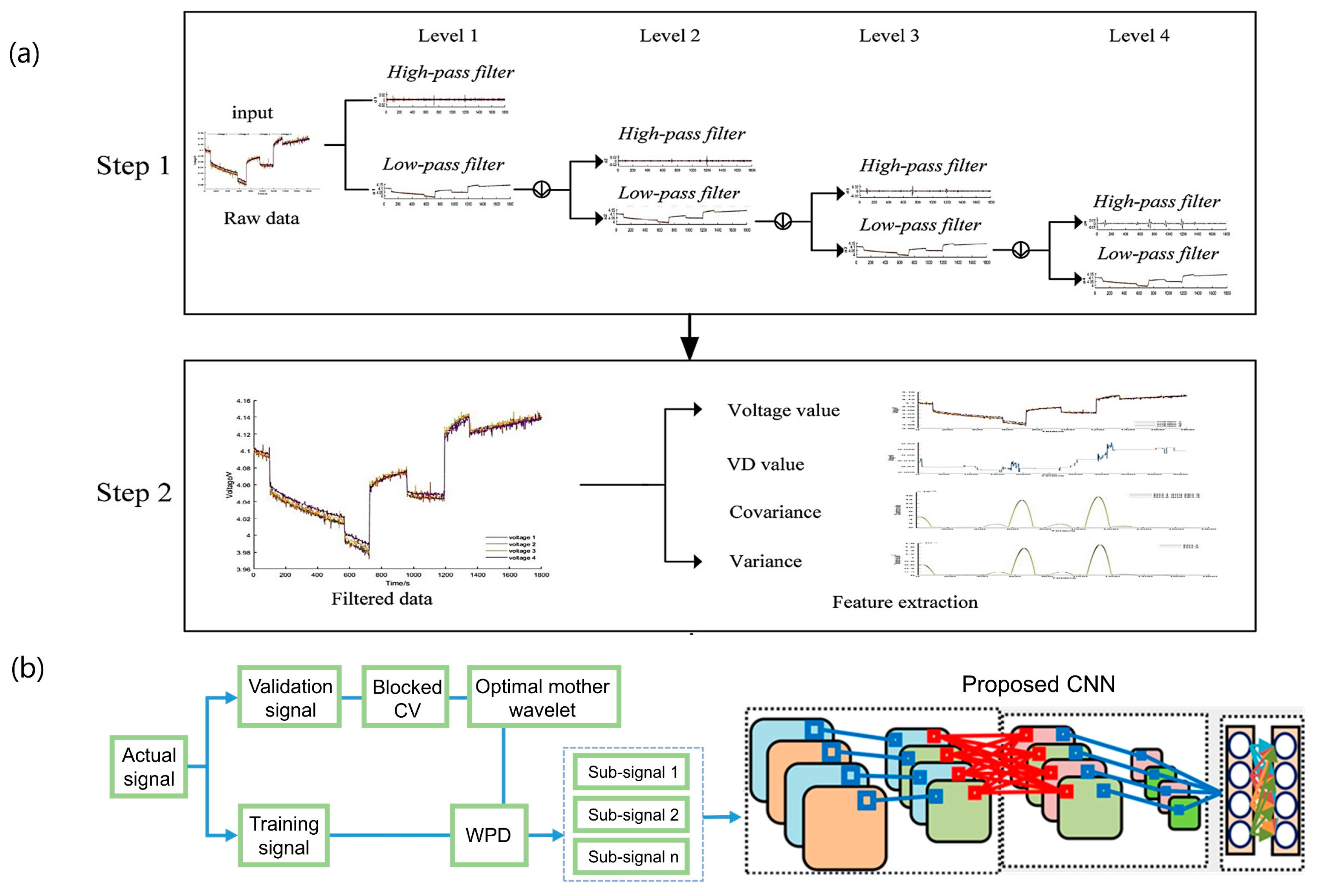
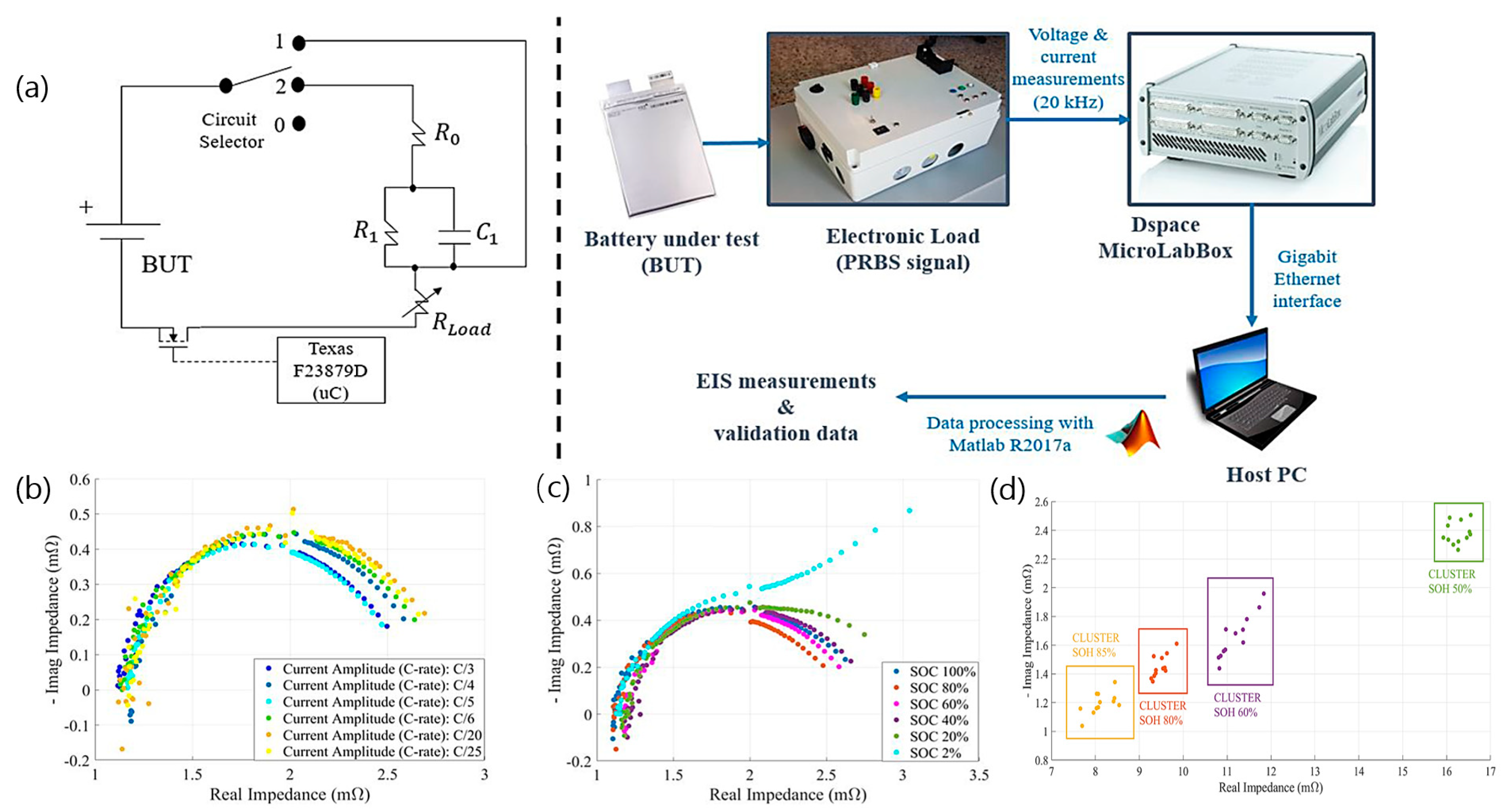
| Fault Mode | Fault Performance | Fault Cause |
|---|---|---|
| Internal short-circuit | High temperature and fast change rate | Thermal, mechanical, and electrical abuse |
| High self-discharge | Low charging voltage and slow rise rate | Internal micro-short circuit or spontaneous chemical reaction |
| Consistency abnormalities | Significant differences in charge/discharge voltage, capacity, internal resistance, temperature, and other parameters between single cells | Poor manufacturing and grouping process, abuse |
| overcharge | High charging voltage, bulging, leakage, etc. | Unreasonable charge control |
| Over-discharge | Low discharge voltage | Control system malfunction |
| Liquid leakage or poor air tightness | Electrolyte leakage or bulge | Poor manufacturing process |
Disclaimer/Publisher’s Note: The statements, opinions and data contained in all publications are solely those of the individual author(s) and contributor(s) and not of MDPI and/or the editor(s). MDPI and/or the editor(s) disclaim responsibility for any injury to people or property resulting from any ideas, methods, instructions or products referred to in the content. |
© 2023 by the authors. Licensee MDPI, Basel, Switzerland. This article is an open access article distributed under the terms and conditions of the Creative Commons Attribution (CC BY) license (https://creativecommons.org/licenses/by/4.0/).
Share and Cite
Zhang, Y.; Jiang, M.; Zhou, Y.; Zhao, S.; Yuan, Y. Towards High-Safety Lithium-Ion Battery Diagnosis Methods. Batteries 2023, 9, 63. https://doi.org/10.3390/batteries9010063
Zhang Y, Jiang M, Zhou Y, Zhao S, Yuan Y. Towards High-Safety Lithium-Ion Battery Diagnosis Methods. Batteries. 2023; 9(1):63. https://doi.org/10.3390/batteries9010063
Chicago/Turabian StyleZhang, Yulong, Meng Jiang, Yuhong Zhou, Shupeng Zhao, and Yongwei Yuan. 2023. "Towards High-Safety Lithium-Ion Battery Diagnosis Methods" Batteries 9, no. 1: 63. https://doi.org/10.3390/batteries9010063
APA StyleZhang, Y., Jiang, M., Zhou, Y., Zhao, S., & Yuan, Y. (2023). Towards High-Safety Lithium-Ion Battery Diagnosis Methods. Batteries, 9(1), 63. https://doi.org/10.3390/batteries9010063





